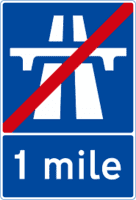End of Motorway Sign, Meaning, Shape & Location
As you transition from the open lanes and controlled access of the motorway to regular roads, there are important considerations that every driver must keep in mind in UK. Discover the End of Motorway Sign, its color, shape, location, and more to recognize it and drive accordingly for safety on the road.
What does this end of motorway Sign mean?
The end of the motorway sign is a blue rectangular sign which informs the drivers that the section of the motorway on which they are traveling and the associated speed limit is ending ahead after the mentioned distance on it. This sign alerts the drivers to be careful and ready to adjust the speed of their vehicle according to the upcoming roadway.
Improve Your Road Signs Knowledge, Take a Free Road Signs Knowledge Test.

End of Motorway Sign Location
The End of Motorway sign is located on the side of the motorway road, a few miles before the end of the motorway section.
Rectangular-Shaped
Guide Road Sign
Blue and White Color
Whenever you see the end of motorway sign while driving, make sure to adjust the speed of your vehicle according to the upcoming roadway. Because the legal speed limit and driving conditions on regular roads are different than on a motorway.
What to Do When Approaching the End of Motorway Sign
When approaching the End of Motorway sign, drivers must be alert, adaptable, and watchful. The following are the main points that motorists need to bear in mind when they see this motorway sign with red line:
- As you came across a end of motorway sign and about to leave the motorway, expect a reduction in the speed limits. To match the new speed limit for the road you are approaching, gradually slow down.
- It’s important to have a safe following distance behind the car in front of you because of the slower speeds and maybe more congested traffic. This allows you enough time to respond to unexpected halt or changes in the direction of the flow of traffic.
- It’s important to have a safe following distance behind the car in front of you because of the slower speeds and maybe more congested traffic. This allows you enough time to respond to unexpected halt or changes in the direction of the flow of traffic.
- Before exiting the highway, check your mirrors and blind areas to verify there are no vehicles around. This helps you merge onto the new road smoothly and safely.
- You’re likely to encounter junctions and roundabouts after exiting the motorway. Pay attention to road signs, signals, and other traffic to navigate these changes in the road safely. Plan your lane changes and signaling well in advance.
- Motorway lanes are typically wider, but other roads may have narrower lanes. Be mindful of the narrower space and avoid drifting between lanes. Maintain a centered position within your lane.
- As you enter urban or residential areas, watch for pedestrian crossings and be prepared to stop for pedestrians.
- Traffic lights might replace the continuous flow of motorway driving. Be prepared to stop at intersections with traffic lights and ensure you follow the appropriate signal for your direction.
- Follow the guidance provided by road signs, signals, and road markings. You will get information about new road conditions from these sign boards,
- Exiting the motorway can sometimes mean encountering slower traffic or congestion. Therefore stay patient and considerate in heavy traffic situation.
- If you’re unfamiliar with the area, use navigation tools to help you navigate the new roads effectively.
This question appeared in the following DMV Tests.

